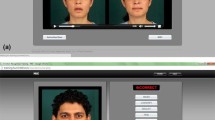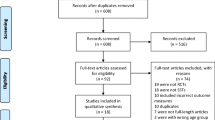Abstract
This study assessed the efficacy of FaceSay, a computer-based social skills training program for children with Autism Spectrum Disorders (ASD). This randomized controlled study (N = 49) indicates that providing children with low-functioning autism (LFA) and high functioning autism (HFA) opportunities to practice attending to eye gaze, discriminating facial expressions and recognizing faces and emotions in FaceSay’s structured environment with interactive, realistic avatar assistants improved their social skills abilities. The children with LFA demonstrated improvements in two areas of the intervention: emotion recognition and social interactions. The children with HFA demonstrated improvements in all three areas: facial recognition, emotion recognition, and social interactions. These findings, particularly the measured improvements to social interactions in a natural environment, are encouraging.



Similar content being viewed by others
References
Adolph, R., Tranel, D., Damasio, H., & Damasio, A. R. (1994). Impaired recognition of emotion in facial expressions following bilateral damage to the human amygdala. Nature, 372, 669–672.
American Psychiatric Association. (1994). Diagnostic and statistical manual of mental disorders (4th ed.). DC: Washington.
Autism Society of America. (2003). New autism facts. Advocate, 36(1).
Bailey, K. J. (2001). Social competence of children with autism classified as best-outcome following behavior analytic treatment. Dissertation Abstracts International: Section B the Sciences and Engineering, 61(12-B), 6696.
Baron-Cohen, S., Ring, H. A., Bullmore, E. T., Wheelwright, S., Ashwin, A., & Williams, P. (2002). Social intelligence in the normal and autistic brain: An fMRI study. European Journal of Neuroscience, 11, 1891–1898.
Baron-Cohen, S., Wheelwright, S., & Jolliffe, T. (1997). Is there a “language of the eyes”? Evidence from normal adults and adults with Autism or Asperger syndrome. Visual Cognition, 4, 311–331.
Bartlett, J. C., & Searcy, J. (1993). Inversion and configuration of faces. Cognitive Psychology, 25, 281–316.
Benton, A. L. (1980). The neuropsychology of facial recognition. American Psychologist, 35, 176–186.
Bernard-Opitz, V. (1989). Computer assisted instruction for autistic children. Journal of Child and Adolescent Psychiatry, 17, 125–130.
Bernard-Opitz, V., Sriram, N., & Nakhoda-Sapuan, S. (2001). Enhancing social problem solving in children with autism and normal children through computer-assisted instruction. Journal of Autism and Developmental Disorders, 31, 377–398.
Bölte, S., Feineis-Matthews, S., Leber, S., Dierks, T., Hubl, D., & Poustka, F. (2002). The development and evaluation of a computer-based program to test and to teach the recognition of facial affect. International Journal of Circumpolar Health, 61(Suppl 2), 61–68.
Bosseler, A., & Massaro, D. W. (2003). Development and evaluation of a computer-animated tutor for vocabulary and language learning in children with autism. Journal of Autism and Developmental Disorders, 33, 653–673.
Boucher, J., & Lewis, V. (1991). Unfamiliar face recognition in relatively able autistic children. Journal of Child Psychology and Psychiatry, 33, 843–859.
Chen, S. H., & Bernard-Opitz, V. (1993). Comparison of personal and computer-assisted instruction for children with autism. Mental Retardation, 31, 368–376.
Cohen, J. (1960). A coefficient of agreement for nominal scales. Educational and Psychological Measurement, 20, 37–46.
Colby, K. (1973). The rationale for computer-based treatment of language difficulties in non-speaking autistic children. Journal of Autism and Childhood Schizophrenia, 3, 254–260.
Corbett, B. A., & Abdullah, M. (2005). Video Modeling: Why does it work for children with autism? Journal of Early and Intensive Behavior Intervention, 2(1), 2–8.
Davies, S., Bishop, D., Manstead, A. S., & Tantam, M. (1994). Face perception in children with autism and Asperger’s Syndrome. Journal of Child Psychology and Psychiatry, 35, 1033–1058.
Ekman, P., & Friesen, W. V. (1975). Unmasking the face. Englewood Cliffs, NJ: Prentice Hall.
Faja, S., Aylward, E., Bernier, R., & Dawson, G. (2008). Becoming a face expert: A computerize face-training program for high-functioning individuals with autism spectrum disorders. Developmental Neuropsychology, 33, 1–24.
Fleiss, J. L. (1981). Statistical methods for rates and proportions. New York: John Wiley & Sons, Inc.
Frith, U. (1989). Autism: Explaining the enigma. Oxford: Blackwell.
Gauthier, I., Skudlarski, P., Gore, J. C., & Anderson, A. W. (2000). Expertise for cars and birds recruits brain areas involved in face recognition. Nature Neuroscience, 3, 191–197.
Golan, O., Ashwin, A., Granader, Y., McClintock, S., Day, K., Leggett, V., et al. (2010). Enhancing emotion recognition in children with autism spectrum conditions: An intervention using animated vehicles with real emotional faces. Journal of Autism and Developmental Disorders, 40, 269–279.
Golan, O., & Baron-Cohen, S. (2006). Systemizing empathy: Teaching adults with Asperger syndrome or high-functioning autism to recognize complex emotions using interactive multimedia. Development and Psychopathology, 18(2), 591–617.
Goldsmith, T. R., & LeBlanc, L. A. (2004). Use of technology in interventions for children with autism. Journal of Early and Intensive Behavior Intervention, 1(2), 166–178.
Gresham, F. M. (1981). Assessment of children’s social skills. Journal of School Psychology, 19, 120–134.
Gresham, F. M., & Elliott, S. N. (1990). Social skills rating system manual. Circle Pines, MN: American Guidance Service.
Hauck, M., Fein, D., Waterhouse, L., & Feinstein, C. (1995). Social initiations by autistic children to adults and other children. Journal of Autism and Developmental Disorders, 24, 129–154.
Heiman, M., Nelson, K. E., Tjus, T., & Gillberg, C. (1995). Increasing reading and communication skills in children with autism through an interactive multimedia computer program. Journal of Autism and Developmental Disorders, 25, 459–480.
Hobson, R. P. (1986). The autistic child’s appraisal of expressions of emotion. Journal of Child Psychology and Psychiatry, 27, 321–342.
Hopkins, M., & Biasini, F. (2005). Children with fragile x syndrome and children with autism show distinct impairments in emotional understanding. Presented at the American psychological society conference, New York, NY.
Joseph, R. M., & Tanaka, J. (2003). Holistic and part-based face recognition in children with autism. Journal of Child Psychology and Psychiatry, 44, 529–542.
Kaufman, A. S., & Kaufman, N. L. (1990). Kaufman brief intelligence test. Circle Pines, MN: American Guidance Service.
Koegel, R. L., Koegel, L. K., & McNerney, E. K. (2001). Pivotal areas in intervention for autism. Journal of Clinical Child Psychology, 27, 233–243.
LaCava, P., Golan, O., Baron-Cohen, S., & Smith Myles, B. (2007). Using assistive technology to teach emotion recognition to students with Asperger syndrome: A pilot study. Remedial and Special Education, 28, 174–181.
LaCava, P., Rankin, A., Mahlios, E., Cook, K., & Simpson, R. (2010). A single case design evaluation of a software and tutor intervention addressing emotion recognition and social interaction in four boys with ASD. Autism, 14, 161–178.
Langdell, T. (1978). Recognition of faces: An approach to the study of autism. Journal of Child Psychology and Psychiatry, 19, 255–268.
Mundy, P. (2003). Annotation: The neural basis of social impairments in autism: The role of the dorsal medial-frontal cortex and anterior cingulated system. Journal of Child Psychology and Psychiatry, 44, 793–809.
Ozonoff, S., Pennington, B., & Rogers, S. (1990). Are there specific emotion perception deficits in young autistic children? Journal of Child Psychology and Psychiatry, 31, 342–361.
Panyan, M. V. (1984). Computer technology for autistic students. Journal of Autism and Developmental Disorders, 14, 375–382.
Perry, A., Condillac, R., Freeman, N. L., Dunn-Geier, J., & Belair, J. (2005). Multi-site study of the Childhood Autism Rating Scale (CARS) in five clinical groups of young children. Journal of Autism and Developmental Disorders, 35, 625–634.
Rhodes, G. (1988). Looking at face: First-order and second order features as determinants of facial appearance. Perception, 17, 43–63.
Sasson, N. J. (2006). The development of face processing in autism. Journal of Autism and Developmental Disorders, 36, 381–394.
Schopler, E., Reichler, R. J., & Renner, B. R. (1988). The childhood autism rating scale (CARS). Los Angeles: Western Psychological Services.
Schultz, R. T., Gauthier, I., Klin, A., Fulbright, R. K., Anderson, A. W., Volkmar, F., et al. (2000). Abnormal ventrical temporal cortical activity during face discrimination among individual with autism and Asperger syndrome. Archives of General Psychiatry, 57, 331–340.
Shah, A., & Frith, U. (1993). Why do autistic individuals show superior performance on the block design task? Journal of Child Psychology and Psychiatry, 34, 1351–1364.
Silver, M., & Oakes, P. (2001). Evaluation of a new computer intervention to teach people with autism or Asperger syndrome to recognize and predict emotions in others. Autism, 5, 299–316.
Sullivan, L. A. (1996). Facial recognition of emotions by children and adults. Dissertation Abstracts International: Section B The Sciences and Engineering, 57(11-B), 7253.
Tanaka, J. W., Lincoln, S., & Hegg, L. (2003). A framework for the study and treatment of face processing deficits in autism. In G. Schwarzer & H. Leder (Eds.), The development of face processing (pp. 101–119). Ashland, OH: Hogrefe & Huber Publishers.
Tanaka, J. W., Wolf, J. M., Klaiman, C., Koenig, K., Cockburn, J., Herlihy, L., et al. (2010). Using computerized games to teach face recognition skills to children with autism spectrum disorder: the Let’s Face It! program. Journal of Child Psychology and Psychiatry, 51(8), 944–952.
Teal, M. B., & Wiebe, M. J. (1986). A validity analysis of selected instruments used to assess autism. Journal of Autism and Developmental Disorders, 16, 485–494.
Whalen, C., Moss, D., Ilan, A., Vaupel, M., Fielding, P., Macdonald, K., et al. (2010). Efficacy of TeachTown: Basics computer-assisted intervention for the Intesntive Comprehensive Autism Program in Los Angeles Unified School District. Autism, 14, 179–197.
Williams White, S., Keonig, K., & Scahill, L. (2007). Social skills development in children with autism spectrum disorders: A review of the intervention research. Journal of Autism and Developmental Disorders, 37(10), 1858–1868.
Yamamoto, J., & Miya, T. (1999). Acquisition and transfer of sentence construction in autistic students: Analysis of computer-based teaching. Research in Developmental Disabilities, 20, 355–377.
Acknowledgments
This study was funded in part by a grant from Civitan International. The author thanks the Autism Lab at UAB, Dr. Franklin R. Amthor as well as Casey Wimsatt, Symbionica, LLC. This paper is adapted from the author’s dissertation.
Author information
Authors and Affiliations
Corresponding author
Rights and permissions
About this article
Cite this article
Hopkins, I.M., Gower, M.W., Perez, T.A. et al. Avatar Assistant: Improving Social Skills in Students with an ASD Through a Computer-Based Intervention. J Autism Dev Disord 41, 1543–1555 (2011). https://doi.org/10.1007/s10803-011-1179-z
Published:
Issue Date:
DOI: https://doi.org/10.1007/s10803-011-1179-z




